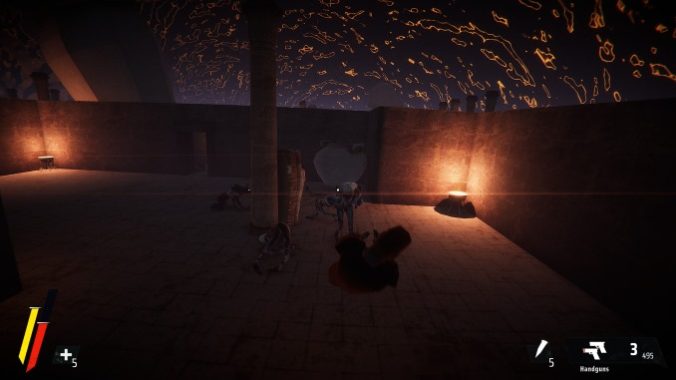
James Savage has a problem. He’s taking an elevator straight down into hell, killing all kinds of demonic beasts along the way, with no guarantee of ever returning. That’s not his problem, though, not really; the whole time he’s reliving the damned relationship with the love of his life, a vampire queen bent on destroying Earth and every human on it. The netherworld that Savage descends into is one “elsewhere” of El Paso, Elsewhere, but so are the memories and emotional and psychological scars left by Janet Drake, aka Draculae—the undead woman who stole Savage’s heart and wants to end the world.
All vampire puns aside, love sucks.
El Paso, Elsewhere does something exceedingly difficult: it’s an action-first game that still focuses heavily on its story, and pulls everything off with a consistent level of care and quality. It’s an intentionally “weird” game that doesn’t owe too much to overly referenced cultural touchstones like Twin Peaks or hoary conspiracy theories, and it’s also blatantly indebted to turn-of-the-century gaming without feeling cliched or unoriginal. (Think Max Payne or PS2-era shooters—that’s what El Paso yearns to evoke.) It invites all manner of comparisons and references, and yet defies almost all of them across its 50 chapters. It stirs a lot of echoes, yet makes a sound that’s entirely and unmistakably its own. It does the job and does it well, with the kind of cohesion you rarely see in games: an expertly calibrated suite of mechanics that interconnect flawlessly, combined with a smart, well-written story and an intricately interwoven soundtrack. I know there are a couple of months left, but I feel pretty safe saying this thing is going to come in near the top of our year-end lists.
Although the level of craftsmanship on display is high across the board, the best decision Strange Scaffold made was dividing the game up into relatively short units. 50 chapters might sound like a ton, but most of them take maybe 10 minutes to complete, even for weirdo completionists like me who have to comb over every part of a level before moving on. (This game is going to be total catnip to speedrunners.) It makes El Paso, Elsewhere a perfect game to pick up and play when you have a few minutes of downtime (especially if you’re playing on PC, and can crank out a quick level on a work break), but also makes it really hard to quit playing, since you know the next level won’t take too long to complete. Even with its relative brevity, it’s easy to lose yourself in this game and keep plunging deeper and deeper into damnation, no matter how little time you planned on spending in it.

“Typical” isn’t really a word that should be used to describe El Paso, Elsewhere, but chapters do have some basic commonalities. The camera rests behind James as you guide him through a variety of impossible spaces; at first it’s a series of motel rooms and hallways that ultimately lead nowhere or twist back onto themselves, and later on those soulless motel spaces combine with graveyards, castles, and other haunts vampires are known for. James packs a small arsenal of firearms—a shotgun, a Tommy gun straight out of an old mob movie, two pistols wielded as coolly and post-Matrix-y (sorry, John Woo-ly) as possible, and more—along with a handful of stakes as he slaughters his way through these unearthly environments, while also rescuing the few kidnapped innocents who haven’t been sacrificed yet. Each gun has a weight to it, not physically but in terms of time; they fire at distinct rates, and have to be reloaded manually, with each weapon having a different reload time. You’ll quickly internalize how much time is needed to fire and reload these guns, and will regularly hop between them when the action is at its most frantic; the tension that creates, along with that dance between James’ movements and cycling through his weapons, gives El Paso a distinct and compelling rhythm regularly emphasized by the game’s original songs.
Time is a major factor of El Paso, Elsewhere, so it’s convenient that James can slow it down when needed. There are two on-screen meters you have to keep an eye on; the red one measures James’ health, which can be restocked by popping vials full of painkillers (self-destruction is a major theme here), and the shorter yellow meter represents his ability to warp into a brief bullet time-style slo-mo mode. It’s easy to get through the first third of the game without ever really having to slow anything down, but eventually, as more and more enemies with different skills and attack ranges are introduced, and larger clusters of them are unleashed at a single time, you’ll be hitting that slow motion button fairly regularly. Strategy becomes necessary, as your meter doesn’t replenish quickly enough for you to slow things down all willy-nilly.
While you’re having to deal with these ever-increasing squads of man-eating goons, you’re also confronted with the unpredictable contortions and undulations of the world around you. The first thing you learn about elsewhere is that it absolutely hates roofs; there’s a constantly churning void of light and shadow above you, which is quickly revealed as a practical design decision by the columns of light that guide you towards your goals in each level. Doors will suddenly close and walls shift behind you as you move past them, forcing you forwards as you free hostages and look for the various colored hearts (yeah, human hearts that glow purple or green or red or whatever, it’s sick y’all) that unlock new corners of the level. If you’re into fluid architecture and impossible geometry like that Dr. Who phone booth and House of Leaves, or whatever, you’ll probably dig the unknowable, illogical levels of El Paso, Elsewhere.

The highlight of each level is when you rescue every hostage and suddenly the lights go out and a single shade (red, it’s usually red, it’s almost always red) coats the walls and enemies stream towards you as you try to rush back to the elevator that connects all these hell-blasted realms and the music slows down dramatically and the bass throbs more heavily and basically everything turns into a dub remix of itself as you shoot your way to freedom. I like that. It’s good.
If there’s one thing I can see players complain grouse about, it’s the degree of difficulty. I would never call El Paso, Elsewhere easy, but it’s definitely not the hardest game I’ve ever played. This is a perk for people like me, who just want to blast through a game and see the story and then write about it and move on to the next, but it takes a while for El Paso to become even slightly difficult. It’s exceedingly generous with pills and ammo, at least early on, and some of its tricks, like hiding enemies behind open doors or in the corners of rooms, are a little overplayed. And even when it does become more complicated, judicious use of pills and that time-slowing technique will often see you through whatever roadblock you might be facing. I would almost never call for a game to be more difficult—seriously, I’ve got like five review codes in my inbox I need to download for next month, and it’s not even October yet—but some might find this one to be a little too much of a breeze, at least early on.
No genuinely good game has ever been hurt by being too easy, though. With El Paso, Elsewhere Strange Scaffold has given us one of 2023’s great games—one that’s in constant conversation with the medium’s past, while simultaneously brushing against the emotional and intellectual boundaries of games. And it does it all with one hell of a sense of a style. El Paso, Elsewhere’s greatness lies not in the excellence of any one of its single components, but in the consistently high level of quality found across all of them. It does everything it tries to do exceedingly well, with sound, image, story, and interaction combining into a uniformly great package. Game designers can learn a lot from El Paso, Elsewhere, and perhaps even act on that knowledge, if their publishers let them.
El Paso, Elsewhere was developed and published by Strange Scaffold. Our review is based on the PC version. It’s also available on Xbox Series X|S and Xbox One.
Senior editor Garrett Martin writes about videogames, comedy, travel, theme parks, wrestling, and anything else that gets in his way.